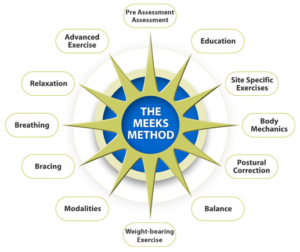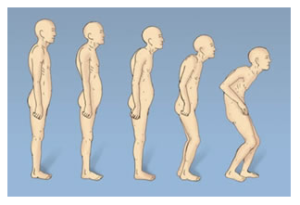Osteoporosis – Stand Tall with Physical Therapy
As we celebrate Halloween today, I can’t help but think about bones. Having healthy bones is important to your overall health. Bones have many functions in the body. Protecting organs, providing structure, storing calcium, and securing muscles are just some of the important functions your bones provide for you. Taking care of your bones during your youth is as important as taking care of your bones in later years. As one gets older, the ability to build bone is decreased. Staying healthy and starting healthy bone maintenance early in life are ways to keep your bones in good shape for the years ahead.
Bone health is important. In our youth, the body makes new bone faster than it breaks down old bone, so your bone mass increases. As you grow older, you lose slightly more bone than you gain. Because you lose bone as you age, getting enough calcium is important in order to help prevent osteoporosis, which causes bones to become weak and brittle. The more bone mass you have, the less likely you are to develop osteoporosis.
Osteoporosis can be an extremely debilitating and painful disease. The Meeks Method utilizes a 12-point program to establish a comprehensive approach to the management of osteoporosis and more. This 12-point program also helps to manage back pain and many other postural dysfunctions. The 12-points are diagrammed below, beginning with Pre-Assessment/Assessment and moving clockwise to education, etc.:
*Used by Permission from Sarah Meeks
When utilizing the Meeks Method for physical therapy, following these points ensures that the client has every aspect covered and nothing is left unattended. This is one of the reasons why utilizing this particular method, I feel, is best for the client because we cover the disease from every angle during therapy sessions. It is a comprehensive approach to healing and can be utilized for not only osteoporosis, but back pain and other postural health issues too.
The Meeks Method is the foundation on which we built our wellness program called Live Your Life TALL & STRONG. This program is specially designed to help with osteoporosis, back pain, and to prevent the postural changes as seen below:
*Postural Change picture used with permission by Sarah Meeks
What are the factors that may put your bone health at risk?
One of the most important things to realize is that the earlier you take action against osteoporosis, the better off you are. If you take care of your bones in your early years you will have a strong base to work with as you age. Below are some of the factors that may play a part in your bone health.
- Race, frame size and family history. If you are exceptionally thin, or have a small body frame, you are at higher risk for osteoporosis because you may have less bone mass to draw from as you age. Likewise, if you have a parent who has osteoporosis, you are at greater risk.
- Hormone levels. Bone loss can be increased by having too much thyroid hormone.
- Physical activity level. People who are physically inactive have a higher risk of developing osteoporosis as compared to those who are active.
- The amount of calcium in your diet. Low calcium contributes to early bone loss, diminished bone density, and increased risk of fractures.
- Being a woman. Compared to men, women have less bone on average. During menopause, bone loss for women increases dramatically due to dropping estrogen levels.
- Males can have bone loss due to low testosterone levels. Low testosterone can cause a loss of bone mass.
- Excessive alcohol consumption and tobacco use. According to research, tobacco use and consuming more than two alcoholic drinks a day increases the risk of osteoporosis. Alcohol can interfere with the body’s ability to absorb calcium.
- Eating disorders and other diseases. People who have bulimia or anorexia are at risk of bone loss. Unfortunately, having stomach surgery, weight-loss surgery and conditions such as Crohn’s disease, Celiac disease and Cushing’s disease can affect your body’s ability to absorb calcium also.
- Getting older. As you age, your bones become thinner and weaker.
- Use of certain medications. There are some medicines that are damaging to the bones. Examples are prednisone, cortisone, prednisolone and dexamethasone. Other drugs used to treat breast cancer, as well as selected antidepressant, anti-seizure, and acid-blocking drugs can also cause bone loss.
What are the ways to help ensure healthy bones?
- Eat high-calcium foods. Dairy products such as milk, cheese, and yogurt are good sources of calcium. The recommended daily dosage of calcium is 1,000 milligrams and increases as we age. Ask your doctor for calcium supplements if it’s difficult for you to find sources of calcium.
- Get plenty of vitamin D. Vitamin D comes naturally from safe intake of sunlight. Foods such as tuna and sardines, as well as egg yolks, fortified milk, or vitamin D supplements are also excellent ways to get your vitamin D. The recommended dosage of vitamin D is 600 international units (IUs) per day and increases as we age.
- Avoid excess protein and sodium. This can lead to an increase in the amount of calcium excreted from the body through urine and feces.
- Avoid smoking and limit alcoholic drinks. Smoking is detrimental to our health in so many ways and damaging our bones is just another one of the many ways it can hurt us. You should also limit alcoholic intake to no more than two glasses a day.
- Take bone-boosting medications. There are slow bone loss medications available on the market. Talk to your physician if you are taking medications that affect your bone health and be sure to monitor bone density or have your physician recommend other possible drug replacements.
- Consider hormone therapy for women. Estrogen, especially when started soon after menopause, can help maintain bone density. However, the use of hormone therapy can increase the risk of blood clots, endometrial cancer and possibly breast cancer. Ask your physician whether hormone therapy is right for you.
- Exercise or at least include physical activity in your regular daily routine. Weight-bearing exercises such as walking, jogging, tennis and climbing stairs can help you build strong bones and slow bone loss.
- Change your routine often when exercising. This will help to surprise your body. This will increase the effectiveness of your exercise, which may lead to stronger, healthier bones.
- Play sports. Not everybody enjoys the same type of exercise. Sports can provide great exercise for your body as well as the movement needed for bone growth. If you enjoy playing sports it can become an easy method to exercising without feeling like you’re forcing yourself.
Don’t hesitate to call us if you have osteoporosis, back pain, or any posture changes that are affecting your quality of life. You don’t have to accept pain, deterioration, and poor posture. Call us to find out more about The Meeks Method and how we can help you Live Your Life TALL & STRONG.
Read about Sarah Meeks here.
Happy Halloween from the staff of Live Your Life Physical Therapy!


